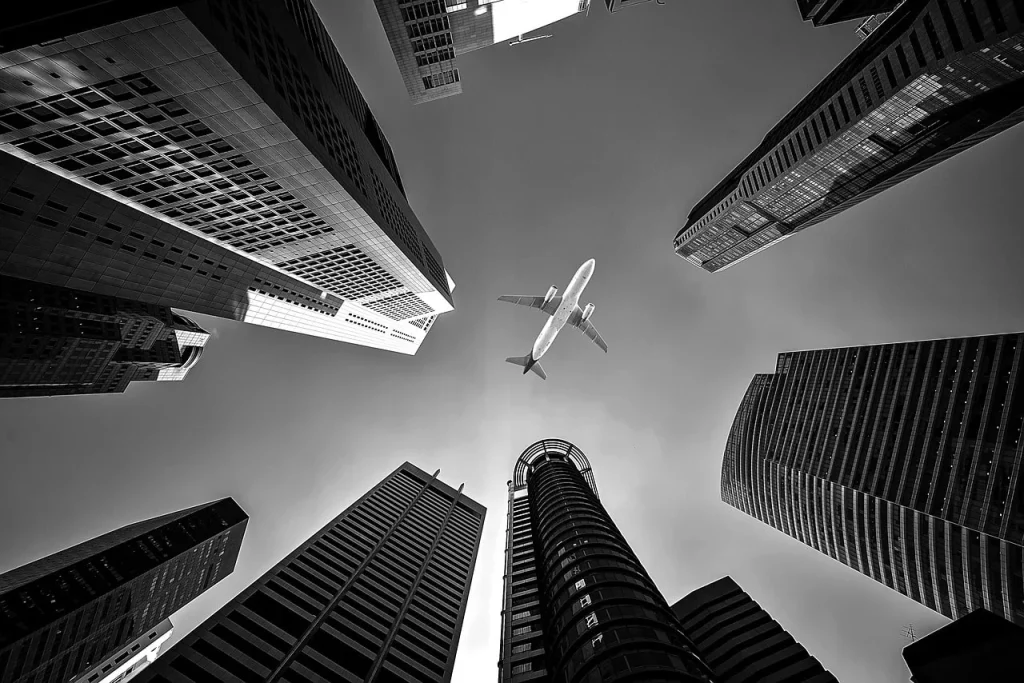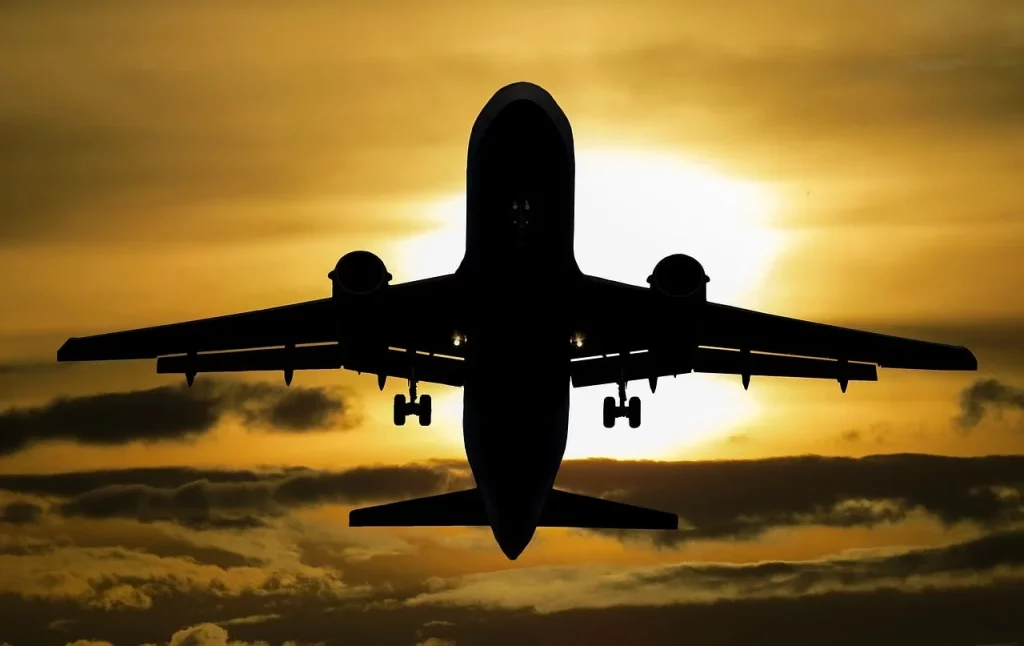Have you ever gazed up at the sky and marveled at the marvel of human engineering soaring above? Airplanes, those giant metal birds, have transformed our world, shrinking continents and connecting cultures.
From the Wright brothers‘ first flight to the latest jumbo jet, these winged wonders never cease to amaze. Did you know that the average cloud weighs about as much as 100 elephants? That’s right, and your flight just sailed right through it!
As we embark on this high-flying journey of some interesting airplane facts, let’s buckle up and ask ourselves, ‘What else don’t I know about these incredible machines?’
The engine is the heart of an airplane, but the pilot is its soul.
Walter Raleigh
Airplane Facts
Before diving in, let me remind you that I created a quiz at the end of the article. Read carefully if you want to master the quiz and become an aviation expert.
- The Wright brothers are credited with inventing and flying the first airplane in 1903.
- Commercial jet airplanes typically cruise at altitudes of 30,000 to 40,000 feet.
- The Boeing 747, often known as the “Queen of the Skies,” has an upper deck, giving it a distinctive hump.
- Supersonic flight is achieved when an airplane travels faster than the speed of sound.
- The black boxes in airplanes, vital for accident investigations, are actually painted bright orange for visibility.
- Winglets at the tips of airplane wings improve fuel efficiency by reducing drag.
- The world’s busiest airport by passenger traffic is Atlanta’s Hartsfield-Jackson International Airport.
- It is estimated that at any given moment, over 9,700 planes are in the sky.
- Boeing’s Everett Factory in Washington is the world’s largest building by volume, where many aircraft are assembled.
- Flight data recorders can withstand extreme heat and pressure.
- Charles Lindbergh made the first solo transatlantic flight in 1927.
- The first female pilot to fly alone across the Atlantic was Amelia Earhart, in 1932.
- Modern airplanes are predominantly made from aluminum and carbon-fiber-reinforced polymers.

- Autopilot systems do not completely replace human pilots but do assist in navigational tasks.
- The Concorde was famous for its supersonic travel, crossing the Atlantic in under three hours.
- Aircraft are struck by lightning more frequently than you might expect, but modern planes are designed to withstand it.
- Heathrow Airport in London is one of the world’s most international airports, with more international passengers than any other.
- Commercial airplanes have an average lifespan of 20-30 years, or 60,000 flight hours.
- Air traffic control systems are crucial for the safe operation of aircraft in busy skies.
- The Antonov An-225 Mriya is the largest airplane ever built.
- Wingtip vortices, created by the difference in air pressure above and below airplane wings, can be a hazard for following aircraft.
- De-icing procedures are essential for safe flight in cold weather, removing ice buildup on the aircraft’s surfaces.
- The concept of pressurized cabins allows passengers to breathe comfortably at high altitudes.
- Jet lag is a common issue for travelers crossing multiple time zones in a short period of time.
- During World War II, the production of military aircraft significantly advanced aviation technology.
- Most commercial airplanes have a maximum operating speed known as Vmo.
- The Airbus A380 is the world’s largest passenger airliner.
- Flying is statistically one of the safest modes of transportation, with a very low accident rate.

- Aircraft tires are designed to withstand heavy loads and high speeds during takeoff and landing.
- The term “Mayday” is used internationally as a distress signal in voice procedure radio communications.
- The Boeing 787 Dreamliner uses composite materials for most of its construction, making it lighter and more fuel-efficient.
- Most commercial jet engines operate on the principle of air compression, fuel mixture, ignition, and exhaust.
- The majority of an airplane’s fuel is consumed during takeoff and climb.
- Flaps on the wings are used to increase lift during low-speed operations like takeoff and landing.
- Pilots and co-pilots are required to eat different meals to avoid the risk of both being incapacitated by food poisoning.
- The first jet aircraft to fly was the Heinkel He 178, in 1939.
- Airlines often schedule longer flight durations than needed to have a better record of on-time arrivals.
- The Chengdu J-20 is a fifth-generation stealth fighter developed by China.

- The Reynolds number, important in aerodynamics, describes the flow characteristics of the air around the airplane.
- In-flight Wi-Fi uses satellite or air-to-ground networks to provide internet access.
- The Boeing 737 is one of the best-selling commercial jetliners of all time.
- During a flight, pilots are constantly communicating with air traffic control and other aircraft.
- The Montgolfier brothers pioneered hot air ballooning, a predecessor to powered flight.
- Airplane windows are made of multiple layers for safety and pressure regulation.
- Emergency oxygen masks in airplanes deploy when the cabin pressure drops significantly.
- The aspect ratio of an airplane’s wing is a significant factor in its aerodynamic efficiency.
- Turbulence, often encountered in flight, is usually harmless but can be uncomfortable.
- Most airplanes are equipped with TCAS (Traffic Collision Avoidance System) to prevent mid-air collisions.
- Jet engines are more efficient at high altitudes due to thinner air and reduced drag.
- The first flight attendants were registered nurses, primarily focused on passenger comfort and safety.
Airplane Myths

Now that we’ve covered all these airplane facts, it’s time to address the myths. Join me as we seek out the truth and debunk common misconceptions in aviation.
- Opening an Airplane Door Mid-Flight is Possible
It is virtually impossible to open an airplane door mid-flight. Airplanes are pressurized, and the cabin pressure creates a force against the door that is far beyond human strength to overcome. - Cell Phones Can Interfere with Airplane Equipment
Modern airplanes are well-shielded against radio interference. While cell phones were once thought to be a risk, it has been found that their signals are too weak to affect navigation or communication systems. - Recycled Cabin Air Spreads Illness
The air in the cabins is heavily filtered and circulated with a mix of fresh air. High-efficiency particulate air (HEPA) filters used in planes capture over 99% of airborne microbes, reducing the risk of spreading illness. - The Autopilot Does Everything
While autopilot systems are sophisticated and can handle many aspects of flight, pilots are constantly monitoring and managing the flight. Autopilot is an aid, not a replacement for skilled human pilots. - Lightning Strikes Cause Airplanes to Crash
Modern airplanes are designed to withstand lightning strikes. The outer skin of the aircraft acts as a conductor, allowing the electrical charge to move along the plane’s exterior without causing damage to the critical systems inside.
No products found.
Airplane Quotes

Airplanes have transformed our world, shrinking distances and connecting cultures. Below is my collection of quotes about them. Let me know yours in the comments so I can add them to the list.
The airplane stays up because it doesn’t have the time to fall.
Orville Wright
Orville Wright, one of the pioneering Wright brothers in aviation, offers a witty observation on the physics of flight, emphasizing the airplane’s continuous motion as the key to staying airborne.
To invent an airplane is nothing. To build one is something. But to fly is everything.
Otto Lilienthal
Otto Lilienthal, an aviation pioneer, differentiates between the innovation, construction, and actual experience of flying, with flying being the ultimate achievement and joy.
In the era of globalization, everything is interconnected. The economy, the political system, the environment, and airplanes are the things that connect it all.
Richard Branson
Richard Branson, the renowned entrepreneur and founder of Virgin Atlantic, underscores the significance of airplanes in linking various aspects of our globalized world, from economics to environmental concerns.
Sometimes, flying feels too godlike to be attained by man. Sometimes, the world from above seems too beautiful, too wonderful, too distant for human eyes to see.
Charles Lindbergh
Charles Lindbergh, famed for his transatlantic flight, reflects on the transcendent experience of flying and the surreal beauty of the world viewed from high above.
I have often said that the lure of flying is the lure of beauty.
Amelia Earhart
Amelia Earhart, a legendary aviator and pioneer for women in aviation, speaks to the intrinsic allure of flying, driven by its inherent beauty and the unique perspective it provides.
Airplane FAQ

As we prepare to land in the FAQ section, remember that these answers are your final information before the quiz. Read each one carefully to soar high in the upcoming challenge.
- How do airplane toilets work?
Airplane toilets use a vacuum system, which is quite different from regular toilets. When you flush, a vacuum sucks the waste into a sanitary tank. This system is lightweight, efficient, and prevents the use of large amounts of water, making it ideal for aircraft where weight and space are crucial. - Can airplanes work with one engine?
Yes, most commercial airplanes are designed to safely fly with just one engine. In the rare event of an engine failure, pilots are trained to handle the situation. The airplane can still take off, fly, and land with one working engine. This is a key aspect of airplane safety standards. - Are airplane seats getting smaller?
There’s a common perception that seats are getting smaller, and in many cases, it’s true. Airlines sometimes reduce seat size and space to accommodate more passengers. However, the size can vary depending on the airline and the type of aircraft. - Can airplanes stop in the air?
Airplanes cannot stop in the air in the way that cars stop on the road. They need constant forward motion to keep the airflow over the wings, which provides the necessary lift. Helicopters, however, can hover in one place, which is a different principle of flight. - How do airplane wings work?
Their wings are designed to create lift. Their shape causes air to move faster over the top of the wing and slower underneath. This difference in speed creates a pressure difference, with higher pressure under the wing and lower pressure above, lifting the airplane into the sky.
No products found.
Airplane Trivia

Get your boarding pass ready for our airplane quiz! But be warned, scoring zero might just parachute you into the infamous ‘Club of Grounded Aviators’.
Conclusion
As we wrap up our aerial adventure, let’s not forget that airplanes are more than machines; they are gateways to new experiences and perspectives. They remind us that the sky is not a limit but a playground for human ambition and creativity.
Let’s close this one with a funny question: If you were to name a new airplane model, what funny name would you choose and why? Let me know your ideas in the comments.
2 Sources Used For This Article

